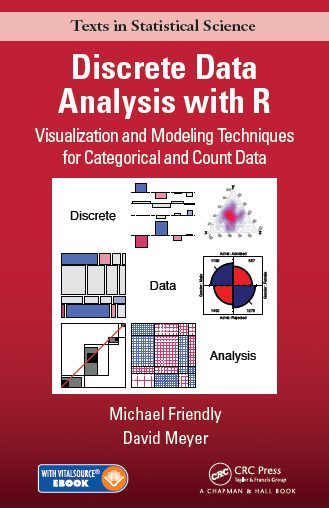Goals
Discrete Data Analysis with R: Visualization and Modeling Techniques for Categorical and Count Data presents an applied treatment of modern methods for the analysis of categorical data, both discrete response data and frequency data.
It explains how to use graphical methods for exploring data, spotting unusual features, visualizing fitted models, and presenting results.
Audience
The book is designed for advanced undergraduate and graduate students in the social and health sciences, epidemiology, economics, business, statistics, and biostatistics as well as researchers, methodologists, and consultants who can use the methods with their own data and analyses. It can be used for self-study, as the primary textbook for a course in categorical data analysis, or as a supplementary text for such a course.
Along with describing the necessary statistical theory, we illustrate the practical application of the techniques to a large number of substantive problems, including:
- how to organize and manipulate categorical data,
- conduct a statistical analysis and fit models,
- produce informative graphs for data exploration and summary, and
- evaluate what the graphs reveal about the data.
We assume the reader has a basic understanding of statistical concepts at least at an intermediate undergraduate level including regression and analysis of variance. In addition, some basic knowledge of R is assumed.
Textbook use
This book is most directly suitable for a one-semester applied advanced undergraduate or graduate course on categorical data analysis with a strong emphasis on the use of graphical methods to understand and explain data and results of analysis.
A detailed outline of such a course, together with lecture notes and assignments, is available at Psychology 6136, using this book as the main text. This course also uses Agresti's An Introduction to Categorical Data Analysis for additional readings.
An instructors manual, containing hints and solutions for the exercises is available.
Features
Provides an accessible introduction to the major methods of categorical data analysis for data exploration, statistical testing, and statistical models.
The emphasis throughout is on computing, visualizing, understanding, and communicating the results of these analyses.
As opposed to more theoretical books, the goal here is to help the reader to translate theory into practical application, by providing skills and software tools for carrying out these methods.
Includes many examples using real data, often treated from several perspectives.
The book is supported directly by the R packages vcd and vcdExtra, along with numerous other R packages.
Each chapter contains a collection of lab exercises, which work through applications of some of the methods presented in that chapter. This makes the book more suitable for both self-study and classroom use.
Ordering information
The book can be ordered through the [publisher's web site] (https://www.crcpress.com/Discrete-Data-Analysis-with-R-Visualization-and-Modeling-Techniques-for/Friendly-Meyer/9781498725835). If you learned of this book through this web site, you may be entitled to a discount, by entering Promo Code AZP97.
It can also be ordered via Amazon.com
